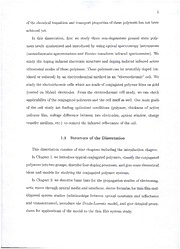
Electrochemical spectroscopy of conjugated polymers PDF
Preview Electrochemical spectroscopy of conjugated polymers
ELECTROCHEMICALSPECTROSCOPYOFCONJUGATEDPOLYMERS By JUNGSEEKHWANG ADISSERTATIONPRESENTEDTOTHEGRADUATESCHOOL OFTHEUNIVERSITYOFFLORIDAINPARTIALFULFILLMENT OFTHEREQUIREMENTSFORTHEDEGREEOF DOCTOROFPHILOSOPHY UNIVERSITYOFFLORIDA 2001 ACKNOWLEDGMENTS Iwouldliketothankmyadvisor,ProfessorDavidB.Tanner,forhisadvice, patience,andencouragementthroughoutmyPh.D.study. Hehasshowedmehow todocondensedmatterphysicsintheinfraredspectroscopyfieldandotherareas ofphysicsstudy. IwasandamveryluckythatIcouldhavestudiedwithhim. IalsothankProfessorsJohnR.Reynolds,PeterJ.Hirschfeld,andArthurF. Hebbard and Associate Professor David H. Reitze fortheir interests in serving onmysupervisorycommittee, forreadingthisdissertationandforgivinggood comments. ProfessorJohnR.Reynoldsallowedmetoattendhisgroupmeetingto getchemistrybackground. Itwasveryhelpfulformetogetchemistryknowledge. Thanksalsoshouldgotoallmypastcolleagues: Dr. AkitoUgawa,Dr. Lev Gasparov,Dr. DorthyJohn,Dr. JoeLaVeigne,andpresentcolleagues,Vladimir Boychev,Dr. LilaTache,AndrewWint,andJasonDeRochefortheirfriendship, usefulconversations, andcooperation. Inparticular,IwouldliketothankIrina Schwendeman,whoismycollaboratorinthechemistrydepartment,forsupplying samplesandsupplyingmesomematerialsforthedissertation. Finally,Iwouldliketogivespecialthankstomywife,SungsoonPark,forher warmsupportandlove. TABLEOFCONTENTS ACKNOWLEDGMENTS u ABSTRACT vi CHAPTERS 1 INTRODUCTION 1 1.1 History 1 1.2 Motivation 3 1.3 StructureoftheDissertation 4 2 REVIEWOFCONJUGATEDPOLYMERS 6 2.1 Non-conjugatedandConjugatedPolymers 6 2.2 ClassificationofConjugatedPolymers 7 2.2.1 DegenerateGroundStatePolymers: DGSPs . . . 9 2.2.2 Non-degenerateGroundStatePolymers: NDGSPs 16 2.2.3 DopingProcessesandApplications 18 2.3 TheoreticalViewofConjugatedPolymers 23 2.3.1 TheoreticalModels 24 2.3.2 Discussion 32 3 THINFILMOPTICSANDDIELECTRICFUNCTION 34 3.1 PropagationofElectromagneticFields 34 3.1.1 PropagationinaHomogeneousMedium 34 3.1.2 PropagationinMaterialwithaSingleInterface 38 3.1.3 PropagationinMaterialwithTwoorMoreInterfaces .... 42 3.2 DielectricFunctionModelandDataFitProcedure 49 3.2.1 DielectricFunctionModel: Drude-LorentzModel 49 3.2.2 DataFitProcedureandParameterFiles 53 3.2.3 OpticalConstants 54 4 INSTRUMENTATIONANDTECHNIQUE 56 4.1 MonochromaticSpectrometers 56 4.1.1 Monochromators 57 4.1.2 ZeissMPM800MicroscopePhotometer 58 4.1.3 Perkin-ElmerMonochromator 64 4.2 InterferometricorFTIRSpectrometer 67 4.2.1 FourierTransformInfraredSpectroscopy 69 4.2.2 Bruker113vInterferometer 76 iii 5 SAMPLEPREPARATION 80 5.1 Monomers,PolymersandotherChemicals 80 5.1.1 ElectrochemicalPolymerizationandDeposition 82 5.1.2 MorphologyofthePolymerFilms 85 5.2 ThinPolymerfilmonITO/glass 87 5.2.1 DopedandNeutralFilmsonITO/glass 88 5.3 ElectrochromicCells 89 5.3.1 ThinPolymerFilmsonGold/Mylar: TwoElectrochromic Cells 90 5.3.2 PreparationofGelElectrolyte 91 5.3.3 ConstructionofElectrochromicCell 91 6 MEASUREMENTANDANALYSISI 93 6.1 SampleDescription 93 6.2 MeasurementTechnique 94 6.2.1 ReflectanceMeasurement 94 6.2.2 TransmittanceMeasurement 97 6.3 DataandAnalysis 98 6.3.1 GlassSubstrate 99 6.3.2 ITO/GlassSubstrates 99 6.3.3 DopedandNeutralPolymersonITO/glass 101 6.4 OpticalConstants 104 6.4.1 OpticalConductivityandAbsorptionCoefficient Ill 6.4.2 ReflectanceandDielectricConstants 113 6.4.3 EffectiveNumberDensityofConductionElectrons 113 6.5 DopinginducedInfraredActiveVibrationModes(IAVMs) 118 6.6 Summary 127 7 MEASUREMENTANDANALYSISII 128 7.1 SampleDescription 128 7.1.1 ThreeOpticalWindows: Polyethylene,ZnSe,andGlass. . . 129 7.1.2 ElectrolyteGel 133 7.1.3 Gold/Mylar 137 7.2 In-situMeasurementTechnique 137 7.3 PEDOT:PBEDOT-CZElectrochromicCell 140 7.3.1 In-SituReflcetanceMeasurement: ElectrochromicProperties 140 7.3.2 ThicknessOptimization 142 7.3.3 DataModelFit 150 7.4 PProDOT-Me2ElectrochromicCell 153 7.4.1 In-SituReflectanceMeasurement 153 7.4.2 SwitchingTime 157 7.4.3 ChargeCarrierDiffusionTest 165 7.4.4 DischargeTest 168 7.4.5 Long-termSwitchingStabilityoftheCell: Lifetime 171 iv 7.4.6 LineScanandLifetime 172 7.4.7 DiscussiononLifetime 177 7.4.8 HysteresisinReflectancevs. CellVoltage 178 7.4.9 DataModelFit 178 7.5 Discussion 184 8 PHYSICSOFCONJUGATEDPOLYMERS 185 8.1 DopingInducedProperties 185 8.1.1 DopingInducedElectronicStructure 185 8.1.2 DopingInducedIAVMs 188 8.2 PropertiesofTheElectrochromicCell 190 9 CONCLUSION 192 APPENDICES A POLARIZEDSPECTROSCOPY 195 A.l CarbonNanotubes 195 A.2 SampleDescription 196 A.3 Measurement 197 A.4 ResultsandDiscussion 198 B ACETONITRILE AND WATER EFFECTS ON ELECTROCHROMIC CELL 203 C MANUALFORZEISSMPM800MICROSCOPEPHOTOMETER . 205 C.l Startup 205 C.2 Measurement 205 C.2.1 Reflectance 206 C.2.2 Transmittance 207 C.2.3 Luminescence 207 C.3 Shutdown 208 REFERENCES 209 BIOGRAPHICALSKETCH 216 AbstractofDissertationPresentedtotheGraduateSchool oftheUniversityofFloridainPartialFulfillmentofthe RequirementsfortheDegreeofDoctorofPhilosophy ELECTROCHEMICALSPECTROSCOPYOFCONJUGATEDPOLYMERS By JungseekHwang May2001 Chairman: DavidB.Tanner MajorDepartment: Physics Conjugatedpolymersbecomeconductorswhentheyaredoped(oxidizedorre- duced).TheinitialworkwasdoneonconductingpolymersbythreeNobellaureates (A.J.Heeger,H.Shirakawa,andA.G.MacDiarmid)in1977. Theydiscoveredan increasebynearly10ordersofmagnitudeintheelectricalconductivityofpoly- acetylenewhenitwasdopedwithiodineorotheracceptors. Conjugatedpolymers havebeenstudiedintensivelysincethattimebecauseoftheirhighconductivity,re- versibledopingandlow-dimensionalgeometry. Dopingcauseselectronicstructure changeswhichhavenumerouspotentialapplications. Wehavestudiedthreethiophenederivativepolymers: poly(3,4-ethylenedioxy- thiophene) (PEDOT),poly(3,4-propylenedioxythiophene) (PProDOT), andpoly (3,4-dimethylpropylenedioxythiophene) (PProDOT-Me2). Twotypesofsampleswereusedforthisstudy. Thefirstwasathinpolymerfilm onanindiumtinoxide(ITO)coatedglassslide. Thepolymerfilmwasdeposited onametallicITOsurfacebyanelectrochemicalmethod.Wemeasuredreflectance andtransmittanceofthesample. Thedatawereanalyzedbymodelingalllayers ofthismulti-layerthinfilmstructure, usingthe Drude-Lorentz modelforeach layer. Wecalculatedtheopticalconstantsfromthemodelingresultsandobtained informationontheelectronicstructureoftheneutralanddopedpolymers. vi Conjugatedpolymerscanbereversiblydopedinanelectrochemicalcell. The doping causes opticalabsorptionbands tomovefromone opticalfrequency to anotherfrequency. Tostudythisbehavior,wepreparedanothertypeofsample. First,athinpolymerfilmwasdepositedonagold-coatedMylarfilmbythesame electrochemicalmethod.Then,webuiltelectrochromiccellswithaninfraredtrans- parentwindow,usingthepolymerfilmsonthegold/Mylarstripsaselectrodes. We connectedthecelltoanelectricalsupply. Aswechangethecellvoltage(potential differencebetweenthetwoelectrodes),wecanchangethedopinglevelsofthecon- jugatedpolymerfilmontheelectrodesreversibly. Ourexperimentshaveaddressed fouraspects: (1)electrochromismofPEDOTandPProDOT-Me2, (2)optimiza- tionofthethicknessofthefilmsinthecellsforthegreatestchangeininfrared reflectance(whichisrelatedtothepolymerabsorbance),(3)theswitchingtimeof thecells,and(4)thelifetimeofthecells. Thelatterisveryimportantforpractical applications. Wepresent theresultsofthesestudiesanddiscussions. We alsogivesome commentsandideasforfurtherstudy. vii CHAPTER1 INTRODUCTION Sincethediscoveryin 1977 [1] ofanincreasebynearly 10ordersofmagni- tudeoftheelectricalconductivityofpolyacetylenewhenitwasdoped (oxidized orreduced) withiodineorotheracceptors (dopants) conjugatedpolymershave beenstudiedintensively. Polyacetylenewasthefirstconjugatedpolymertoshow thisspecial electrical property. A numberofresearchers in physics, chemistry, andmaterialssciencehavebeenstudyingconjugatedpolymersfromseveraldif- ferentperspectives. Studiesoftheelectronicstructureoftheneutralanddoped conjugatedpolymershaveopenedpotentialapplicationareas: electro-,thermo-, orsolvato-chromicdevicesaspassiveelements,andphoto-orelectro-luminescence devicesasactiveelements. Studiesonchargetransportationofdopedconjugated polymerstudyhaveopenednewphysicsareas: transportationmechanismsinthe conjugatedpolymersystems,andrelationshipsbetweenmorphologiesandcharge transportaions. Inthisintroductorychapterwegiveaverybriefreviewofthehistoryofcon- jugatedpolymers,motivationofthestudy,andorganizationofthedissertation. 1.1 History Conventionalpolymers, whicharesaturatedpolymersorplastics, havebeen usedformanyapplicationstraditionallybecauseoftheirattractivechemical,me- chanical,andelectricallyinsulatingproperties. Althoughtheideaofusingpoly- mersfortheirelectricallyconductingpropertiesdatesbackatleasttothe1960s[2], 2 theuseoforganic"7rconjugated"polymersaselectronicmaterials[1,3]inmolec- ularbasedelectronicsisrelativelynew. Pristine(neutralorundoped)conjugatedpolymersareinsulatorsorsemicon- ductors. However, whentheconjugatedpolymersare "doped" (oxidizedorre- duced) theycanhavemetallicelectricalconductivity [4,5]. Inadditiontothe studyofthehighelectricalconductivities,whichcanbeappliedtothemanufac- tureofconductingtransparentplastic[6]andconductingfabrics[7],thefastand highnonlinearopticalapplicationofconjugatedorganiccompoundsisalsoatopic ofmajorinterest[8]. Inthe1980stheconceptsofsolitons,polarons,andbipolaronsweredeveloped, inthecontextofbothtransportproperties[9-13]andopticalproperties[1,14]. Morerecently,conjugatedpolymersarereceivingattentionasapromisingma- terialsforelectronicapplications. Inparticular, conjugatedpolymersaswellas 7r-conjugatedoligomers [15] playacentralroleinorganic-basedtransistorsand integratedcircuits[16,17],photovoltaicdevices[18]andespeciallyorganic-based lightemittingdevices[19]. Even solidstate lasers are under development [20]. In fact, in the caseof polymer-basedlightemittingdevices(LEDs),thedevelopmentofdevicestructures hasledtotheestablishmentofhigh-techcompaniesandacademicinstitutes[21, 22]. Recently,somegroupsareintensivelystudyingelectrochromism[23-28],ther- mochromism[29],andalsoelectrochromicdevices[30,31]madefromconjugated polymers. 1.2 Motivation Conjugatedpolymershavealternatingsingleanddoublebondsintheirback- bone. Alongtheirbackbonetherearestrongaandircovalentbonds,andbetween thepolymerchainstherearecomparativelyweakVanderWaalsbonds. Sothe systemsarequasi-one-dimensional. Thesesystemssharemanycommoninterest- ingphysicalphenomenawiththelowdimensionalphysicalsystem: organiccharge transfersalts, high-Tcsuperconductors, etc. Conjugated polymersystemshave unusualtransportphenomenabecauseoftheirnon-perfectcrystallinityandlow- dimensionalgeometry. Alsotheelectronicstructureofthesesystemsevolvesan interestingwaywhentheyaredoped(oxidizedorreduced)bychemicalorelectro- chemicalmethods. Typical conjugated polymers can be classified into two groups: degenerate groundstatepolymer(DGSP)andnon-degenerategroundstatepolymer(NDGSP). DGSPisaconjugatedpolymerwhichkeepsthesamegroundstateenergywhen singleanddoublebondsinitsbackbonesareinterchanged(Sec. 2.2.1). However, NDGSPhasdifferent groundstateenergy whensingleanddoublebondsinits backbonesinterchanged(Sec. 2.2.2). Polymersindifferentgroupsshowdifferent doping-inducedpropertiesbecauseoftheirdifferentgeometries. Onemainissueinthephysicsoftheconjugatedpolymersorcorresponding oligomersisthestrongcouplingbetween theelectronicstructure, thegeometric (morphological)structure,andchemical(bondorderingpatternorlattice)struc- ture. Alargenumberofstudiespublishedduringthelasttwodecadeshaveopened anewfieldinmaterialsscienceextendingoversolidstateandtheoreticalphysics, syntheticchemistry,anddeviceengineering. However,acompleteunderstanding
